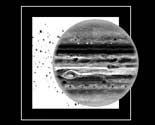
Te Marama o Matariki He Maramataka Mäori - Hakihea
Seventh Month of the Mäori Year - December/January
Ka maranga mai a Pareärau i muri atu i a Tamanui te Rä. Kei te püäwai te Rewarewa me te Ngaio. E kï ana ngä manga o te Porokaiwhiri i te huaräkau. E täkaro whiu teka te Tiemiemi me te Kapowai i roto i te wera. Ka rongohia te reo o ngä pïpï manu, e waiata mai ana i o rätou köanga. He wä mutunga mö te whakatö i ngä huawhenua.
Jupiter rises after the Sun. Honeysuckle and Ngaio are in flower. Pigeonwood branches are covered with fruit. Blue Damselfly and Common Dragonfly dart around in the heat. Young chicks can be heard and seen in their nests. The last of the crops are now planted.
Te Tohu o Kaupeka - Pareärau
Sign of the Season - Jupiter
‘He whetü nui a Pareärau, he wahine karihika, he wahine tiweka’
‘The great star Jupiter, an immoral woman, a wandering woman.’
This whakatauäkï (proverb) is a reference to the wanton ways of Pareärau as she traverses the heavens. At this time of the year Pareärau rises in the morning beside Köpü (Venus), her companion. Over the course of following nights in the season however, Pareärau wanders away and is associated with numerous stars and other planets throughout the seasons.
When Pareärau rises the last of the crops will be planted.
Pareärau (as Jupiter), known also as Hine-i-tiweka and Köpünui, is a giant ball consisting of hydrogen and helium gas, is greater in size than all of the moons and other planetsPareärau combined.
Both Jupiter and Saturn are known as Pareärau, a direct reference to the cloud bands of Jupiter and rings around Saturn.
Another distinctive feature is the ‘eye’ of Jupiter, a swirling mass of gas and dust particles known as the Great Red Spot. Although Jupiter takes almost twelve years to orbit the Sun, it rotates on its axis much faster than all other planets, one ‘day’ on Jupiter equals around 600 minutes or ten hours on Earth.
When a shimmering halo of mist surrounded the bright yellow-white planet a storm, or wet-weather season approached. It is said that some Tohunga, Mäori priests with great mana, who were sufficiently versed in the ways of the heavens and heavenly bodies, were known to utilize this occurrence at will. When these Tohunga needed to communicate with distant regions they created the phenomenon of the shimmering halo of mist around Pareärau.
Rä Pare (Thursday) honours Pareärau (as Jupiter).

